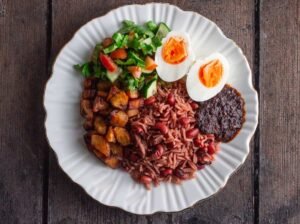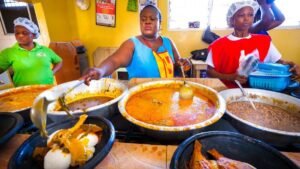Ghanaian cuisine is bold, spicy, rich in flavor, and deeply rooted in culture and tradition. Whether you’re a street food explorer or a sit-down restaurant diner, Ghana’s food scene offers an unforgettable journey through its diverse ethnic flavors. For first-time visitors, understanding what to eat—and how to eat it—adds a whole new layer to your cultural experience.
Here are 10 must-try Ghanaian dishes that capture the country’s culinary soul, with helpful context on what’s in them, how they’re eaten, and where to find them.
1. Jollof Rice
What it is: A one-pot tomato-based rice dish cooked with onions, garlic, bell peppers, and spices, often served with fried plantain and grilled meat or fish.
Why you should try it: Jollof is West Africa’s most famous culinary rivalry, and Ghana’s version is spicier and more fragrant than its Nigerian counterpart.
Best place to try: Any local “Chop Bar” or restaurants like Azmera or Buka in Accra.
Tip: Ask for it with shito (a spicy black pepper sauce) on the side for a real flavor boost.
2. Waakye
What it is: A breakfast or lunch dish made from rice and black-eyed beans, often served with boiled eggs, fried plantain, spaghetti, gari (cassava flakes), and meat or fish.
Why you should try it: It’s a complete meal in a single plate, offering textures and flavors that are uniquely Ghanaian.
Best place to try: Street vendors in Accra or Tamale during mid-morning to lunch hours.
Tip: Go early—waakye sellers often sell out before noon.
3. Fufu and Light Soup
What it is: Fufu is a soft, stretchy dough made from cassava and plantain, pounded and served with a spicy tomato-based soup often made with goat, chicken, or fish.
Why you should try it: Fufu is a staple in most Ghanaian homes and is traditionally eaten with the fingers—no chewing the fufu itself, just swallow.
Best place to try: Local chop bars or traditional restaurants in Kumasi, like Asanka Local.
Tip: Ask for “goat light soup” or “tilapia light soup” if you’re adventurous.
4. Banku and Grilled Tilapia
What it is: Banku is a fermented corn and cassava dough, rolled into balls and paired with grilled tilapia and spicy pepper sauce (shito or kpakpo shito).
Why you should try it: This dish is a favorite along Ghana’s coast and reflects both Ga and Ewe influences.
Best place to try: Beachside eateries in Accra or Tema, or riverside restaurants in the Volta Region.
Tip: Eat with your hands—it enhances the experience.
5. Kenkey with Fried Fish and Shito
What it is: Fermented cornmeal wrapped in corn husks and steamed, served with fried fish, fresh pepper sauce, and onions.
Why you should try it: It’s the Ga people’s signature dish and a street food classic across southern Ghana.
Best place to try: Local markets or roadside vendors in Accra.
Tip: Try both Ga Kenkey and Fante Kenkey—they differ in fermentation and flavor.
6. Red Red (Beans Stew with Fried Plantain)
What it is: A flavorful stew made from black-eyed peas cooked in palm oil with tomatoes, onions, and spices. It’s served with fried ripe plantains.
Why you should try it: It’s a comforting vegetarian-friendly option that’s both sweet and savory.
Best place to try: Home-style restaurants or university canteens in Accra and Cape Coast.
Tip: Add avocado slices if in season for a creamy finish.
7. Tuo Zaafi (TZ)
What it is: A northern Ghanaian staple made from maize or millet flour, served with green leafy soup (ayoyo) and meat or fish.
Why you should try it: It’s lighter than fufu and reflects the rich culinary traditions of the northern regions.
Best place to try: Tamale or any northern-style restaurant in Accra.
Tip: Be prepared to eat with your hands—TZ is all about texture and ritual.
8. Kelewele
What it is: Spicy fried plantains marinated in ginger, cayenne, garlic, and other spices.
Why you should try it: Kelewele is a beloved snack or side dish with sweet heat and crunchy edges.
Best place to try: Evening street vendors across Accra, especially around Osu and Madina.
Tip: Great with groundnuts (peanuts) as a combo snack.
9. Chinchinga (Ghanaian Kebab)
What it is: Grilled skewers of spicy beef, chicken, or gizzard coated in a suya-style peanut and chili rub.
Why you should try it: It’s Ghana’s answer to barbecue and a popular night snack.
Best place to try: Street grills near pubs or events—look for smoke and crowds.
Tip: Ask for extra spice if you can handle the heat.
10. Boiled Yam and Palava Sauce
What it is: Soft white yam chunks served with palava sauce—a rich stew of cocoyam leaves (or spinach), agushi (melon seeds), and either meat or fish.
Why you should try it: It’s nutritious, hearty, and steeped in Ghanaian culinary tradition.
Best place to try: Local chop bars or lunchtime buffets at traditional restaurants.
Tip: Palava sauce is a fantastic vegetarian option when made without meat.
Bonus: Don’t Miss These Accompaniments
- Shito: A spicy black pepper sauce made with dried fish, shrimp, and chili—served with almost everything.
- Sobolo: A refreshing hibiscus drink spiced with ginger and cloves.
- Pito: A local millet beer, popular in northern Ghana.
Tips for Food Lovers Traveling in Ghana
- Eat where locals eat: If it’s busy, it’s probably good.
- Ask what’s spicy: Many dishes pack heat—request mild if you’re not used to pepper.
- Try food tours or cooking classes: Available in Accra and Kumasi for deeper exploration.
- Use your hands (when appropriate): It’s part of the experience—just wash well first.
- Don’t judge by appearance: Some of the most flavorful meals come in humble packaging.
Final Thoughts
Ghanaian food is deeply satisfying, full of character, and as diverse as its people. Whether you’re sampling spicy jollof rice, dipping fufu in aromatic soup, or biting into sizzling kebabs by the roadside, every meal tells a story of heritage, pride, and community. As a first-time visitor, be open, be curious, and come hungry—Ghana will feed both your appetite and your soul.




